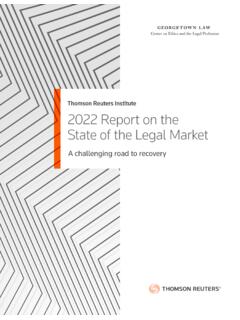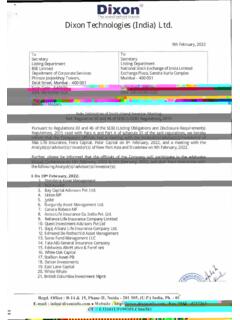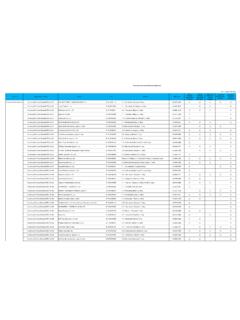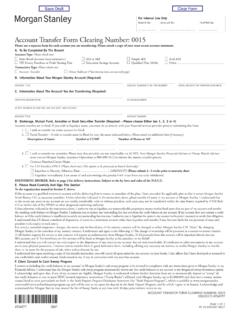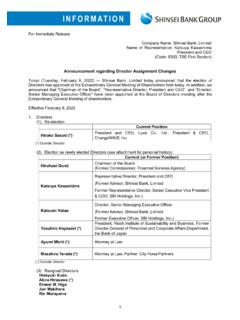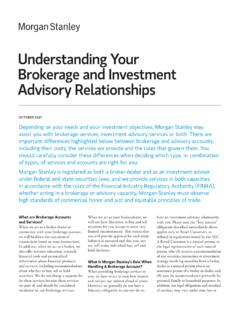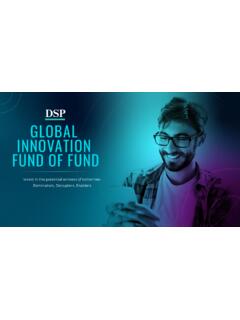Transcription of A New Quality Factor: Finding Alpha with ASSET4 ESG Data
1 A NEW Quality FACTOR: Finding Alpha with ASSET4 ESG DATA Date of issue: 31 March 2010 STARMINE RESEARCH NOTE Jason M. Ribando, George Bonne, EXECUTIVE SUMMARY On November 30, 2009, Thomson Reuters announced the acquisition of ASSET4 , the leading provider of environmental, social, and corporate governance (ESG) data. ASSET4 gathers extensive, objective, quantitative and qualitative ESG data on 3100 global companies (as of Q2 2010) and scores them on four pillars: Environmental, Social, Corporate Governance, and Economic. In turn, the pillar scores form the basis of an overall company score summarizing a company s strength in adhering to ESG principles. with its origins in Socially Responsible Investing (SRI), the ideas behind ESG investing have been gaining more traction in the recent decade because of environmental issues surrounding global warming and corporate governance issues leading to the demise of several large firms.
2 Yet, ESG information is still largely ignored by many investors and represents an untapped source for enhanced portfolio strategies. We have undertaken a study to determine the efficacy of ASSET4 scores as equity selection factors . We find that in addition to displaying significant stand-alone performance, ASSET4 signals complement other Quality factors such as StarMine Earnings Quality (EQ). Our results show the ASSET4 scores add value on an absolute basis as well as a risk-adjusted basis, and that their value-added generally increases with the investment holding period. These results are consistent with the theory that companies that score highly on ESG principles are focused on creating long-term shareholder value.
3 The results are good news for fund managers who invest with a conscience. The entire history of ASSET4 ESG data, dating back to fiscal year 2002, is available to customers in .zip file format, in the AssetmasterProfessionalTM system, and via Excel Add-In functionality. ASSET4 ESG data will soon be distributed through various Thomson Reuters platforms including Datastream, Market QA, Reuters 3000 Xtra, Reuters Knowledge Direct, and Thomson ONE Analytics. The data are completely transparent for every security and can be viewed as scores or raw data at all levels in the ASSET4 data framework. The current universe includes complete coverage of the FTSE 250, MSCI Europe, MSCI World Index, Russell 1000, and S&P 500 and is continually being expanded to meet customer needs.
4 BACKGROUND ESG INVESTING AND ASSET4 ESG investing has been around since at least the early 1980 s in various guises. In its early stages ESG was referred to as Socially Responsible Investing and funds like Amy Domini s SRI fund steered clear of sin companies having any involvement with alcohol, gambling, tobacco, and defense. Today, SRI has morphed into ESG and encompasses a much wider agenda. Companies practicing good ESG policies decrease their environmental impact by reducing carbon emissions and water usage, are socially responsible in their treatment of employees and their role in the community, and establish corporate governance best practices for an independent, fairly compensated board that protects shareholders rights.
5 A New Quality Factor: Finding Alpha with ASSET4 ESG Data 2 Date of issue: 31 March 2010 Recognizing the trend in ESG investing and responding to the need for transparent ESG data, ASSET4 was founded to become the leading provider of objective, comparable and auditable extra-financial information. ASSET4 provides professional investors and corporate executives access to the world s largest database of ESG information and the analysis tools to integrate that information into their everyday decision making. ASSET4 is a proud signatory of the UN's Principles for Responsible Investment and a contributing member to organizations and initiatives like: UNEP-FI, Eurosif, UKSIF, USSIF, Nachhaltiges Investment and the Ceres Coalition.
6 Thomson Reuters acquired ASSET4 in late 2009 in order to offer this unique and transparent data set to its customers. Proponents of ESG investing seek financial reward for investing in sustainable companies dead companies can t earn profits which are able to recruit top talent and are protective of shareholders rights. The downside to following ESG principles is that it can be costly in the near term to install emissions scrubbers, create a safe and healthy workplace for employees, and establish a fairly compensated independent board. ESG investors take a long horizon view, choosing like-minded companies and company management who create long-term shareholder value rather than focusing on short-term gains and the next quarterly statement.
7 In fact, many ESG investors view adherence to ESG principles as a proxy for good company management. Such managers have an awareness of the company s role in the community at-large and the global marketplace, have the bandwidth to address issues that aren t immediate to the bottom line, and manage for long-term value creation rather than short-term performance goals. From a risk mitigation point of view, ESG investors try to avoid companies at high risk of being subject to costly events such as environmental clean-ups and lawsuits or losses arising from corporate malfeasance and fraud. As such, incorporating ESG information into an investment process has the potential to reduce risk and minimize exposure to severe blow-ups.
8 As an example of the predictive power of extra-financial information, consider the ASSET4 ESG scores of Bear Stearns prior to its collapse in March 2008. As shown in Figure 1, Bear Stearns had alarmingly low ESG scores compared to its banking rivals Goldman Sachs and morgan stanley . Bear Stearns s Integrated Rating ranked near the twelfth percentile of global companies, and only 32 of 2258 companies had a worse Economic pillar score. In fact, Bear Stearns had received consistently poor ASSET4 ESG scores since coverage began in 2002, largely owing to its dearth of transparent reporting of extra-financial information. Bear Stearns never would have belonged to a portfolio being screened for ESG factors . Figure 1: Comparison of ASSET4 ESG scores of Bear Stearns, Goldman Sachs, and morgan stanley in early 2008.
9 ASSET4 scores for Bear Stearns were significantly lower than those of rivals Goldman Sachs and morgan stanley and had been for several years before Bear Stearns collapsed. scoreESG factorESG Scores for Three Big BanksWhen Bear Stearns CollapsedBear StearnsGoldman SachsMorgan StanleyA New Quality Factor: Finding Alpha with ASSET4 ESG Data 3 Date of issue: 31 March 2010 ESG INVESTING TRENDS AND THE DEBATE ON VALUE-ADDED Dollar amounts committed to SRI and ESG investment vehicles continue to grow even while the debate persists whether these practices add value to the investing process. The Social Investment Forum (SIF) reports that the global market for SRI, shareholder activist, and ideological-based investing exceeded $5 trillion in the year 2007.
10 In that year $ trillion in assets, or of the total investment market, was devoted to SRI, an 18% increase over the last time it was measured in 2005 (Social Investment Forum, 2007). At the end of 2009, a review of 160 socially responsible mutual funds representing 22 Forum members found that 65% of funds outperformed their benchmarks (Social Investment Forum, 2010). Without question, increasing demand from institutional and individual investors to incorporate ESG criteria into the investment process is driving more assets towards ESG funds. Nonetheless, there exists debate whether the short-term costs of implementing ESG practices outweigh the long-term advantages. In its earlier stages, SRI and ESG investors presumed that they might pay a premium in the form of lower returns for principled investing.




